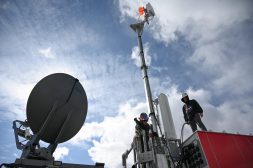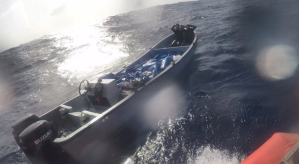US Strategic Command nominee acknowledges shortfalls in electronic warfare operations, training

The Trump administration’s nominee to serve at the helm of U.S. Strategic Command told lawmakers Thursday that the Pentagon’s ability to test, exercise and conduct electronic warfare operations are inadequate.
“We’re not where we need to be, but we’re focused on it and making progress,” Vice Adm. Richard Correll, who currently serves as Stratcom’s deputy commander, said during his confirmation hearing in front of the Senate Armed Services Committee.
While Stratcom is primarily responsible for overseeing the Defense Department’s nuclear capabilities and global strike missions, it is also charged with leading the military’s joint electromagnetic spectrum operations. The command manages those EMS efforts from the Joint Electromagnetic Spectrum Operations Center (JEC), established in 2023 to increase the U.S. military’s readiness within the spectrum.
But Correll stressed to lawmakers both during his confirmation hearing and in written responses to advance policy questions that there is still much work to be done to integrate EW into the Defense Department’s operational plans.
Furthermore, the joint force’s ability to test capabilities and train troops for future conflicts is limited due to increasing congestion in the electromagnetic spectrum, he added.
“We’ve got to continue along all efforts to advance our spectrum capabilities,” he said. “That includes world class test ranges, modeling and simulation and testing ourselves against the most exquisite capabilities that are out there. That’s where the joint force is headed.”
The Pentagon is limited in its ability to conduct open-air electronic warfare tests and training exercises at the joint level due to overcrowding in the spectrum, a lack of adequate ranges and frequent interference, Correll noted in his responses to advance policy questions. Simulation capabilities are also constrained, despite the department’s efforts to fund and upgrade its capabilities.
The military is working to modernize its EW capabilities through the Electronic Warfare Infrastructure Improvement Plan, which includes the Navy’s Surface Electronic Warfare Improvement Program (SEWIP) and Electronic Warfare Infrastructure Improvement Program (EWIIP).
Correll noted that capabilities developed from the initiatives are currently being fielded on the joint force’s test and training ranges, but there is likely more to be done to accommodate future warfighting requirements.
“The complexity of testing the ever increasing integrated and meshed sensors and weapons systems the Joint Force demands requires modular open systems approach-enabled lab environments,” he wrote. “Coupled with agile software, digital twins, and replicative systems, these environments can then maximize pre-fielded testing, best capitalizing return on investment while protecting operational security.”
Recent exercises have also demonstrated deficiencies in the Pentagon’s ability to train for electronic warfare operations — an issue that, when compounded with a lack of blue force capabilities, have resulted in the joint force’s “inability to maintain previous EMS advantages,” Correll said. As a result, the department must leverage alternative training methods best suited for complex electronic warfare.
“While live, virtual and constructive approaches are able to mitigate some of these gaps in training, they cannot fully capture the true fog, friction, and realism of warfare down to the tactical level,” Correll wrote. “Based on cost-benefit analysis these solutions must be adopted from a modular open systems approach in order to best capitalize return on investment.”
Correll further stressed that there is still much work to be done to integrate EW operations into the Defense Department’s operational plans. A key challenge is educating the joint force, including senior leadership, on electromagnetic spectrum capabilities and how they can be used during ops, he said.
“Integrating EMS into our operational plans requires understanding how EMS operations impact all weapons and systems and is a critical component of the EMS Superiority Strategy Implementation Plan,” he wrote, referring to the Pentagon’s 2020 strategy. “Spectrum-dependent systems are the norm now, and how these systems are employed must be carefully planned to account for any countermeasures’ effect.”






